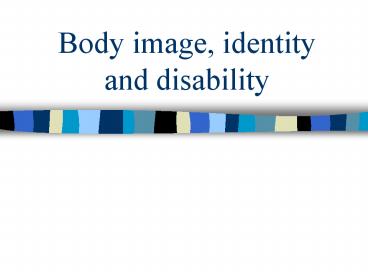Body image, identity and disability - PowerPoint PPT Presentation
1 / 22
Title:
Body image, identity and disability
Description:
Exercise 1. How do you perceive your own body? ... eating, exercise, body image. social ... Ageing processes. etc... IDENTITY. Social stigma (Goffman, 1963) ... – PowerPoint PPT presentation
Number of Views:456
Avg rating:3.0/5.0
Title: Body image, identity and disability
1
Body image, identity and disability
2
Objectives of the lecture
- Give evidence based review of literature
- Assess the pros and cons of todays ideal body
image - Make students more aware of their own personal
responses to their own body image and that of
other people
3
Social construction of the desired body
- Media,
- Fashion,
- Modelling
Has society created unrealistic physical
expectations? Where does disability fit?
4
Exercise 1How do you perceive your own body?
- Trying to define yourself is like trying to bite
your own teeth. - Alan Watts (1961)
- Do you contradict yourself in your own thoughts?
- Society exists only as a mental concept in the
real world there are only individuals. - Charley Reese (b.1937)
5
Society todaywhat is normal morphology?
- Over 7 million women worldwide suffer from
disorders linked to body image e.g. anorexia,
bulimia, and BDD (body dismorphic disorder) - Men are amongst the fastest growing group of
sufferers (body builders have low self esteem,
Blouin Goldfield, 1995) - What are the effects of living with a physical
disability in todays society?
6
Body Image
- An evaluation of body size, weight or any other
aspect of the body that determines physical
appearance (Thompson, 1990) - bridges the mind-body dichotomy
PERCEPTION
RESPONSE
INTERPRETATION
7
- Inter-related Variables
- eating, exercise,
- body image
- social pressure, media images, competitiveness
- education, treatment, peers
identity
8
Physical disability
- Seen vs unseen
- Extent of restraint
- Independence vs dependence
9
Body image and psychology
- Health and illness (e.g. effects on body image
have been found with women suffering breast
cancer) - Amputation and physical disability
- Ageing processes
- etc
10
IDENTITY
- Social stigma (Goffman, 1963)
- Internalisation (Thompson Haran, 1984)
- Self concept (Taleporos McCabe, 2002)
11
Exercise 2How do you describe your own identity?
- I bid him look into the lives of men as though
into a mirror, and from others to take an example
for himself (Adelphoe)
12
SOCIAL IDENTITY THEORY
- His or her display or ascription to, membership
of some feature-rich category (Antaki
Widdicombe, 1998) - Social / personal identity polarisation?
- Membership attributes
- Time / place / external effects (e.g. familial
disruption) - So is identity how we organise and construct our
world? (Sacks, 1960)
13
- Interplay social context of a personal world
- The two cannot be defined completely separately
- Identity is in a state of flux
- Research social situations and situational
analysis - Talk is always action performative (Edwards,
1998)
14
Body image, identity, and disability the research
- Acquired disability focus denial, coping and
acceptance mechanisms, stages of adjustment are
not sequential nor the same for all - Physical disablement can cause unrelenting
tension (Laurence, 1991) - Research fails to include those born with a
disability or those with degenerative conditions
15
Examples of research
- Wolman et al. (1994)
- 3000 adolescents survey examining body image
- Findings those with physical disability,
especially those with chronic conditions, scored
lower on body image subscales - Failed to take account of seen/unseen, extent of
restriction, etc.
16
Quantitative findings discussed
- Not all research finds a significant difference
between the body image and self esteem of
disabled/non-disabled (Nelson Gruver, 1978) - Does a measure of self esteem really tell us
enough.???
17
Qualitative research of body image and disability
- Taleporos and McCabe, 2002
- 7 individuals with severe mobility problems
- In-depth interviews
- Three themes emerged internalisation of ve
attitudes bodily acceptance over time and
mediating factors in the altered body
18
My own research
- 19 students with physical disabilities were
interviewed (in-depth and exploratory) - Themes
- rejection of the label
- Individuality and treatment
- Timeline of disability
- Restraint
- Otherness and Internalisation
- Pain
- Coping and acceptance
- Positives
19
Discussion of my research
- Within group differences were more prominent,
theory of otherness not adequate - Recognition of stigmatisation
- Conceptualisations formed through the interview
- Presents a far more complex picture regarding
body image, where we see an interplay between
social experience, identity and
conceptualisations of disability
20
From conclusions to future research
- My research suggests that we need to be aware of
conceptualisations of disability prior to
examination of an individuals body image - Complex interplay of variables
- Further research needs to specify condition,
extent of disability, etc.
21
Society - research continuum
- New identities needed for disabled people
- Less social stigmatisation
- Research which illustrates a balanced view of
disability and promotes disability awareness in
society
22
Food for thought
- What sort of research designs would your employ
with regards to disability research? (body image/
identity) - What variables would you need to consider?
- How would you disseminate your findings?































